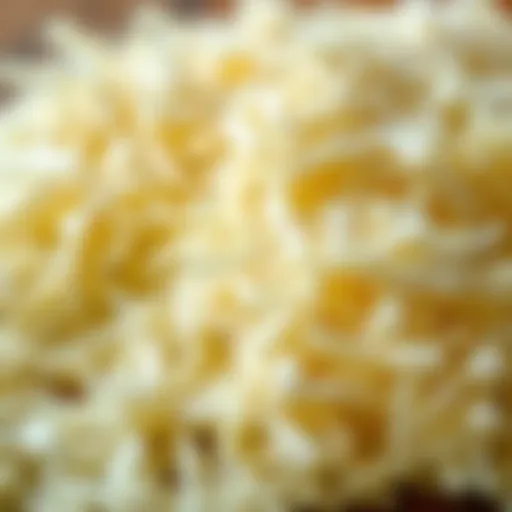The Art of French Fries: A Comprehensive Study
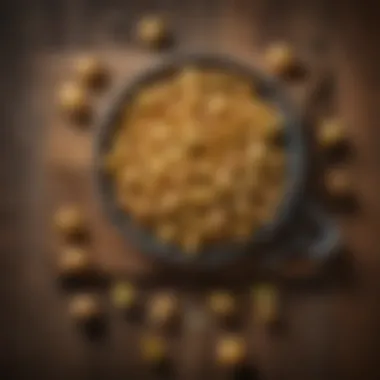

Intro
French fries hold a unique place in culinary history. Originating in Belgium or France, their exact beginnings are debated, but their popularity has spread globally. The dish has numerous variations, each reflecting cultural influences. To fully grasp the art of making French fries, one must understand the underlying processes and techniques involved in their preparation.
Understanding French fries requires more than just knowledge of ingredients. From selecting the right potato type to frying methods and seasoning, every choice impacts the final outcome. This piece aims to dissect each element, offering insights and practical guidance.
The journey begins with the recipe overview, leading into the specifics of ingredient selection and necessary techniques.
Prelims to French Fries
The exploration of French fries begins with understanding their significance in culinary traditions across the globe. French fries, originating from potatoes, exemplify simplicity and indulgence, appealing to a broad audience. This article presents an in-depth examination of their preparation and cultural relevance.
French fries are not merely a side dish; they serve as a canvas for various culinary expressions. They can absorb flavors, whether as a vessel for rich sauces or a complement to diverse seasonings. Understanding their essence provides insight into the beloved status they hold in gastronomy.
Origins of French Fries
The exact origins of French fries are a topic of debate. Some records trace them back to Belgium, where street vendors fried the first potatoes, calling them "french fried potatoes." Others attribute the inception to France, where they are referred to as "pommes frites." Historical documents suggest that they emerged in the late 17th century.
Throughout time, French fries have evolved. They transitioned from a humble fried snack to an essential component of fast food. As they gained prominence, their preparation method also diversified, influenced by different cultures and cooking technologies.
Cultural Significance
French fries carry more than just taste; they embody cultural identities and shared experiences. From casual quick-service restaurants to gourmet establishments, they adapt to various dining contexts. In the United States, fries share a notable connection with hamburgers, becoming staples of American cuisine.
Different countries celebrate their fries uniquely. In Canada, poutine—a dish combining fries, cheese curds, and gravy—illustrates how national ingredients merge to create a distinct culinary experience. In the Netherlands, they enjoy with mayonnaise, highlighting their versatile nature.
"French fries, while simple in concept, reveal the intricacies of our global palate."
Thus, comprehending the origins and significance of French fries allows for a deeper appreciation of this iconic dish. They represent unity, versatility, and creativity, serving as a reminder of culinary evolution.
Understanding Potatoes
Understanding potatoes is crucial for anyone interested in making the perfect French fries. Potatoes are the foundation of this dish. Their type and quality can change the texture, taste, and overall enjoyment of fries. Knowing which potato varieties work best can significantly impact the frying process and the final product.
Potato Varieties Suitable for Fries
When it comes to choosing potatoes for French fries, two main categories dominate the selection: starchy potatoes and waxy potatoes. Starchy potatoes, such as Russet and Idaho varieties, are especially favored for frying. They have a high starch content and low moisture, which helps create crispy exteriors while keeping the insides fluffy.
Some common potato varieties that are suitable for making fries include:
- Russet Potatoes: These are the most popular choice for fries. They offer a light, airy texture and crispy crust.
- Yukon Gold Potatoes: These potatoes have a creamy texture and a buttery flavor, although they might not get as crispy as Russets.
- Maris Piper: Known for its versatility, this variety produces fries that are both crisp and fluffy.
Waxy potatoes, such as Red Bliss or new potatoes, contain less starch and more moisture. While they can be used for frying, they do not yield the same level of crispiness and may not be ideal for traditional French fries.
The Science of Starch in Potatoes
The science of starch plays a significant role in the texture of French fries. Starch granules in potatoes gelatinize when heated, causing them to absorb moisture. This process enhances the fry's texture by allowing the outside to crisp while the interior becomes light and fluffy. The key is to understand the starch levels in different potato types.
When frying, the correct temperature is vital. Frying at around 325°F (163°C) is often recommended for the first fry, allowing the starch to absorb the necessary heat. A second fry at a higher temperature, around 375°F (190°C), finishes the cooking process, ensuring a crispy outer layer.
Here are a few points to remember about starch:
- High-Starch Potatoes: Perfect for frying due to their ability to create crispiness.
- Low-Starch Potatoes: These do not crisp well, making them less favorable.
- Soaking Potatoes: This step can help remove excess surface starch, leading to better frying results.
"The dual frying technique is essential for achieving that perfect balance of texture in French fries."
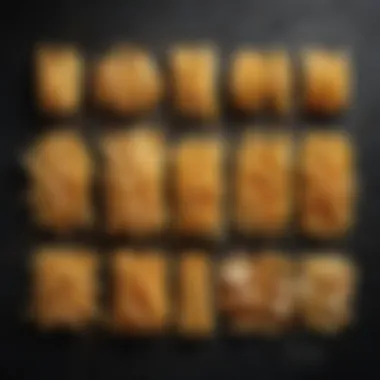

By understanding the importance of potato varieties and the science of starch, cooks can significantly elevate their French fry game. This knowledge allows one to choose the right potatoes and fry them to achieve optimal results.
Preparation Techniques
Preparation techniques play a crucial role in the art of making French fries. The way potatoes are handled before frying can dramatically affect the taste and texture of the final product. A careful approach to preparation ensures that the fries achieve the right balance of crispiness and softness, allowing the inherent flavors of the potatoes to shine through.
A key aspect of preparation is knife skills. Proficient knife skills not only improve safety in the kitchen but also contribute to uniformity in the size of the fries. Uniform fries cook evenly, leading to consistent quality. Moreover, the type of cut influences the cooking time and the overall texture, making it an essential component in fry preparation.
Selecting the Right Knife Skills
The selection of appropriate knife skills is fundamental when preparing French fries. It begins with choosing the right knife. A sharp chef's knife is often preferred for its versatility and precision. The goal is to create fries that are uniform in size for optimal cooking.
Here are some important points on knife skills:
- Safety First: Always use a cutting board and ensure the knife is sharp to prevent slips.
- Grip: Hold the knife firmly yet comfortably to maintain control. Use the pinch grip for better stability.
- Technique: The claw technique, where the fingers are curled back, protects them from the blade while guiding the potato.
"Cutting techniques significantly enhance the cooking process and the final flavor profile of the dish."
Praciticing these skills not only elevates the cooking experience but also builds confidence in the kitchen.
Different Cuts for French Fries
There is a variety of cuts that can be employed when preparing French fries, and each has its unique characteristics and culinary implications. Choosing the right cut is essential for achieving the desired texture and cooking time. Common cuts include:
- Classic Cut: The traditional cut, often known as steak fries, are thicker. They offer a tender center and a crisp exterior.
- Julienne Cut: This method produces long, thin fries which cook quickly and can crisp uniformly.
- Crinkle Cut: A wavy pattern is created which enhances the surface area, allowing for more browning and crunch.
- Shoestring Cut: Very thin fries that are extra crispy due to their small size but need precise time and temperature control.
Each of these cuts serves a different purpose, and personal preference plays a role in deciding which method to use. Additionally, considering the accompanying dip or seasoning can guide the choice of cut. Ultimately, the selected cut impacts not only the experience but also the enjoyment of the fries.
Frying Methods
Frying methods play a crucial role in defining the texture, flavor, and overall quality of French fries. Understanding the differences among various frying techniques can significantly enhance the culinary experience. The choice of method affects the amount of oil absorbed, the crunchiness of the outer layer, and the softness of the inside. Each technique has its own unique attributes, benefits, and considerations that cater to diverse preferences and dietary considerations. In this section, we will discuss traditional deep frying, modern air frying, and oven baking techniques to provide a well-rounded understanding of how these methods contribute to the art of French fries.
Traditional Deep Frying
Traditional deep frying involves submerging the fries in hot oil, usually around 350°F. This method consistently results in a crispy exterior and a fluffy interior. The deep frying process also seals the potatoes quickly, preventing excessive oil absorption, which is essential for achieving that golden color and texture most people associate with French fries.
Key aspects of traditional deep frying include:
- Oil Selection: High smoke point oils like peanut or canola oil are optimal. They maintain stability at high temperatures.
- Batch Cooking: Frying in small batches ensures that the oil temperature remains constant, delivering better results.
- Time Management: Cooking time is generally between three to five minutes, depending on the thickness of the fries.
Air Frying: A Modern Alternative
Air frying has surged in popularity as a healthier alternative to traditional deep frying. This method utilizes hot air circulation to cook the fries, resulting in a crisp texture with significantly less oil. The air fryer combines the principles of convection and conduction to ensure that the fries are even cooked.
Advantages of air frying include:
- Reduced Oil Usage: Air frying requires only a tablespoon or two of oil, decreasing calorie content considerably.
- Faster Cooking Times: The hot air circulation allows for quicker cooking, often within 15 to 20 minutes.
- Versatility: Air fryers can also prepare a variety of foods, making them a multi-functional kitchen appliance.
However, there are considerations such as:
- Texture Differences: While air-fried fries can be crispy, they may not achieve the same level of crunch as deep-fried ones.
- Batch Size: Depending on the model, air fryers may have smaller capacity, which may require cooking in multiple batches.
Oven Baking Techniques
Oven baking offers another alternative that supports healthier eating habits while still delivering satisfying results. This method involves spreading seasoned potatoes on a baking sheet and cooking them in the oven at temperatures typically around 425°F. While oven-baked fries may not always achieve the same crispiness, certain techniques can optimize their quality.
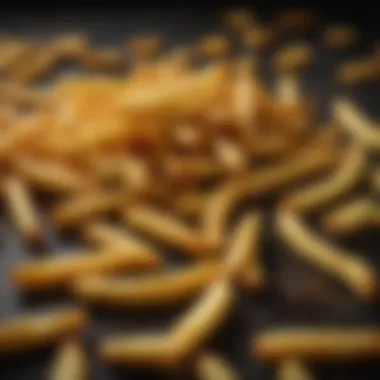

To enhance oven baking:
- Proper Preheating: Always preheat the oven to ensure even cooking from the start.
- Spreading: Arrange the fries in a single layer with space to allow air circulation, which promotes even browning.
- Timing & Temperature: Bake for 20 to 30 minutes, flipping halfway through for more uniform texture.
The oven method can also accommodate a variety of seasonings or coatings, contributing to unique flavor profiles.
Importance of Oil Selection
Selecting the right oil is crucial in creating the perfect French fries. The type of oil impacts not just the flavor but also the texture and health aspects of the dish. Certain oils can withstand the high temperatures needed for frying, while others may degrade, leading to off-flavors and unhealthy compounds. An appropriate oil selection contributes to achieving the desired golden crispiness and mouthfeel.
Additionally, the smoking point of the oil plays a significant role. Oils with higher smoke points are better for frying as they can withstand the heat required without burning. This point is vital for both flavor preservation and safety. Using the correct oil also enhances the overall health profile of the fries, making it a key consideration for those who are health-conscious.
Types of Oils for Frying
Several types of oils may be used for frying French fries, each with distinct characteristics:
- Canola Oil: A favorite among many chefs, it has a high smoke point around 400°F (204°C) and a neutral flavor. This allows the natural taste of the fries to shine.
- Peanut Oil: Known for its rich flavor, peanut oil can withstand high temperatures (about 450°F or 232°C). This oil is often used in Asian cooking but pairs well with fries too.
- Sunflower Oil: Another neutral option, sunflower oil is high in unsaturated fats and has a smoke point close to that of canola oil. It's a versatile choice.
- Duck Fat: For those seeking a gourmet twist, duck fat adds flavor complexity to fries. Its smoke point is around 375°F (190°C).
- Olive Oil: Although it’s acceptable for frying, extra-virgin olive oil has a lower smoke point (around 375°F or 190°C). However, when used properly, it can elevate the taste significantly.
Each oil’s characteristics influence how the fries absorb flavors and develop their final texture. Experimenting with different oils can yield exciting results.
Temperature Control in Frying
Controlling the frying temperature is a vital element in the cooking process for French fries. The optimal frying temperature generally ranges between 325°F (163°C) and 375°F (190°C), depending on the frying method and desired outcome. If the oil temperature is too low, the fries will absorb more oil, resulting in a greasy texture. Conversely, if the oil is excessively hot, the exterior may brown too quickly, leaving the inside undercooked.
Achieving the right temperature can ensure that the fries cook evenly and develop a crispy exterior while remaining fluffy on the inside. To monitor the oil temperature accurately, using a thermometer is recommended. This way, you can maintain the consistency needed for frying, resulting in fries that are well-balanced in taste and texture.
Maintaining the correct frying temperature is crucial for achieving the ideal crunch and flavor in your French fries.
In summary, oil selection and temperature control are significant factors in frying French fries. Choosing the appropriate oil and ensuring proper cooking temperatures can enhance the dish, bringing out the best in the humble potato-based delicacy. These foundational aspects are essential whether frying at home or running a professional kitchen.
Seasoning and Flavoring
Seasoning and flavoring are critical elements that elevate French fries from simple potato snacks to a culinary delight. The efficacy of different seasonings can enhance texture and improve taste, providing layers of flavor that engage the palate. Thoughtful seasoning can transform a basic dish into a gourmet experience, while also reflecting individual preferences and regional culinary traditions.
Classic Seasoning Techniques
Classic techniques in seasoning French fries typically involve the use of common ingredients such as salt, pepper, garlic powder, and paprika. Salt is the most fundamental seasoning—it enhances the natural flavor of the potatoes and draws out moisture, creating a satisfying crunch. Nutritional benefits also come from spices like paprika, which adds a hint of smokiness without overwhelming the palette.
- Salt: Should always be added immediately after frying for maximum absorption.
- Pepper: Freshly cracked black pepper provides depth and slight heat.
- Garlic Powder: Introduces a savory note that pairs well with the crisp fry texture.
- Paprika: A touch of paprika can improve visual appeal and add mild spice.
Employing these techniques can be done using a variety of methods:
- Tossing the fries in a bowl with seasonings right after frying.
- Sprinkling seasonings during the cooking process, especially in oven-baking or air-frying.
Innovative Flavor Combinations
In recent years, more adventurous flavor combinations have emerged, appealing to a broader audience. These combinations can surprise and delight anyone. Experimenting with different herbs and spices leads to exciting variations. Some popular innovative techniques include:
- Truffle Oil: Drizzling fries with truffle oil offers a rich, earthy flavor that appeals to gourmet enthusiasts.
- Cheese Seasoning: Various cheese powders can add complexity. Parmesan and cheddar cheese accentuate the umami notes.
- Cilantro and Lime: A splash of lime juice combined with fresh cilantro creates a refreshing contrast to the fried flavor.
- Buffalo Sauce: Drenched fries in homemade or store-bought buffalo sauce give an entirely new dimension with spicy tang.
"The right seasoning transforms the ordinary into the extraordinary."
Combining textures, such as crispy sea salt or toasted sesame seeds, can also elevate the eating experience. By incorporating unique ingredients, cooks can customize their fries to suit any occasion, from casual snacking to elegant dinners.
Modern Trends in French Fries
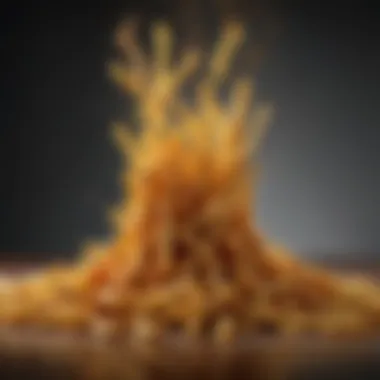

The exploration of modern trends in French fries is essential for understanding the evolving landscape of this beloved dish. Today’s food culture demonstrates a growing appreciation for gourmet interpretations of French fries, as well as a shift towards healthier options. This section illuminates key elements that are not just trends but also pivotal transformations in how fries are presented and consumed.
Gourmet French Fries
Gourmet French fries have emerged as a culinary adventure, pushing the bounds of traditional preparation methods. They are no longer simply a side dish; instead, they have become a canvas for creativity in the kitchen. Various gourmet restaurants are now incorporating unique ingredients, cooking techniques, and intricate presentation styles into their fry offerings.
"Gourmet French fries are rising in popularity, often featuring rich toppings such as truffle oil, parmesan, or even lobster."
Some of the most notable elements of gourmet fries include:
- Flavor Infusions: Utilizing unique seasonings or marinades during the frying process.
- Innovative Toppings: From garlic aioli to spicy sriracha sauces, diners can find fries topped with everything from bacon bits to exotic cheeses.
- Global Influences: Many establishments are drawing inspiration from diverse cuisines, providing a range of fries that reflect cultural tastes and preferences.
In this trend, the focus is not solely on flavor but also on the overall dining experience, emphasizing aesthetics, opportunity for sharing, and the joy of indulging in elevated comfort food.
Health-Conscious Alternatives
With the global rise in awareness about health and wellness, the demand for health-conscious alternatives to traditional fries is also substantial. This trend reflects a broader shift in dietary preferences and an increased interest in sustainable eating practices. Modern fries are being offered in ways that prioritize nutrition without sacrificing taste.
Several aspects of health-conscious alternatives include:
- Oven-Baked Fries: Using less oil, these fries offer a crisp texture with reduced calories.
- Vegetable-Based Options: Not only potatoes, but also sweet potatoes, zucchini, and even cauliflower are being used to create healthy fry alternatives, appealing to those looking for lower carbohydrate options.
- Air Frying Techniques: This method significantly lowers fat content. It uses circulating hot air to cook fries, giving a satisfyingly crunchy texture.
Overall, the emphasis on health in the world of French fries serves as a response not only to mainstream dietary trends but also to a deeper understanding of culinary practices that support well-being. As chefs adapt to these preferences, they continue to innovate, ensuring that flavor and health can coexist harmoniously in this iconic dish.
Serving Suggestions
The section on serving suggestions plays a crucial role in elevating the experience of enjoying French fries. While the preparation and cooking methods are essential components, how fries are served can significantly influence their appeal and enjoyment. This part of the article highlights the various accompaniments that enhance the flavor profile of fries and provides insights into pairing them with main dishes, ultimately showcasing the versatility of this beloved snack.
Accompaniments for French Fries
Accompaniments can transform the humble French fry into a culinary delight. There are several options that complement the textures and flavors of fries, offering a range of experiences:
- Dipping Sauces: Various sauces, such as ketchup, mayonnaise, and aioli, can enhance the taste. Experimenting with flavorful blends like garlic mayo or spicy sriracha can add an exciting twist.
- Cheese: Cheese sauces, such as nacho cheese or a drizzle of melted cheddar, can create a rich topping. Crumbled feta or parmesan can also add a gourmet touch.
- Herbs and Spices: Fresh herbs like parsley or cilantro can provide brightness. A sprinkle of smoked paprika or chili flakes can infuse a different depth of flavor.
- Garnishes: Items like crispy shallots or bacon bits can add texture and richness. A squeeze of lemon can also bring acidity, balancing the dish.
These accompaniments allow for personalization, catered to different tastes and preferences. They also provide opportunities to introduce regional flavors, reflecting culinary traditions.
Pairing with Main Dishes
French fries can serve as an ideal side, pairing well with a variety of main dishes. This flexibility allows cooks to create a complete meal with well-balanced flavors. Some effective pairings include:
- Burgers: The classic combination of burgers and fries is beloved worldwide. The savory and juicy qualities of a burger perfectly complement the crunchy, salty potatoes.
- Fried Chicken: The contrast of crispy chicken with fluffy fries creates a satisfying experience. Both items absorb flavors from the seasonings used, enhancing the overall profile.
- Steak: Serving fries alongside a perfectly cooked steak can appeal to a sophisticated palate. The richness of the steak balances the simplicity of fries, making for an excellent presentation.
- Fish and Chips: This British classic showcases the pairing beautifully. The batter from the fish complements the fries, creating a unity of textures and flavors.
Epilogue
The conclusion of this article serves as an essential synthesis of the multifaceted exploration into French fries, illuminating the heart of this beloved dish. Understanding the various processes from potato selection to cooking techniques enriches the cooking experience for both novice and seasoned chefs. Furthermore, it highlights how ingrained French fries are in various culinary traditions worldwide, showcasing their adaptability and cultural relevance.
Key elements discussed validate the importance of technique, ingredient selections, and modern interpretations of French fries. Considerations about healthier frying options, like air frying and innovative toppings, reflect a growing trend toward nutritionally conscious eating. By embracing these changes, culinary enthusiasts can enjoy this classic dish without compromising on health.
Ultimately, the significance of this topic extends beyond mere preparation. It encourages a deep appreciation for the art and science involved in making French fries. Readers leave with practical insights, enhancing their kitchen skills while embracing culinary diversity.
Summary of Key Points
In this article, we examined several key aspects of preparing French fries:
- Origins and Cultural Significance: Uncovered the historical roots and variations across different regions.
- Potatoes: Discussed suitable varieties for fries, focusing on starch content and texture.
- Preparation Techniques: Implemented essential cutting skills and different styles of fries.
- Frying Methods: Evaluated traditional frying, air frying, and oven baking, weighing pros and cons of each.
- Oil Selection: Identified types of oils and the importance of temperature control for crispiness.
- Seasoning: Examined classic and innovative flavor profiles to enhance taste.
- Modern Trends: Explored the rise of gourmet fries and health-conscious alternatives.
- Serving Suggestions: Provided ideas for accompaniments and pairings with main dishes.
Future of French Fries
As we look towards the future, the evolution of French fries seems poised to continue. Simple potatoes are being reimagined in diverse culinary landscapes, driven by changing consumer preferences. Health considerations are likely to accelerate innovation in lighter cooking options and alternative ingredients.
In addition to this, gourmet trends seem to expand at a rapid pace. Chefs and home cooks alike are finding new ways to elevate French fries with gourmet toppings, unique seasonings, and fusion-style preparations. This not only enhances flavor but also offers visually appealing presentations.
Finally, as technology continues to influence cooking methods, we can expect to see further advancements in frying appliances, making it easier to achieve perfect fries at home. Sustainable practices, such as using organic potatoes and eco-friendly oils, might also reign in response to growing environmental awareness.













